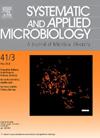Characterization of Sphingomicrobium aquimarinum sp. nov. and Sphingomicrobium maritimum sp. nov. highlights astaxanthin-producing bacteria in the family Sphingomonadaceae
IF 4.2
2区 生物学
Q2 BIOTECHNOLOGY & APPLIED MICROBIOLOGY
引用次数: 0
Abstract
Bacteria are considered as better models for industrial production of astaxanthin (AXT) because of their fast growth and convenience for the downstream extraction. Nevertheless, few bacterial species of native AXT producers are explored to date. In this study, bacterial strains XHP0235T (=GDMCC 1.3093T = MCCC 1K07532T = JCM 35574T) and XHP0239T (=GDMCC 1.3086T = MCCC 1K07530T = JCM 35575T) were isolated from coastal seawater of China. Polyphasic taxonomy suggested that strains XHP0235T and XHP0239T were closely related to Sphingomicrobium aestuariivivum AH-M8T, S. arenosum CAU 1457T, and S. astaxanthinifaciens CC-AMO-30BT, and should be recognized as two novel species of the genus Sphingomicrobium, for which the names Sphingomicrobium aquimarinum sp. nov. and Sphingomicrobium maritimum sp. nov. are proposed, respectively. Comparative genomic analysis revealed the complete AXT pathway (genes crtB, crtI, crtY, crtZ, and crtW) present in strains XHP0235T, XHP0239T and the three relative strains, and the carotenoid-targeted metabolome analysis confirmed the productions of AXT and other carotenoids. Inspired by these findings, the AXT pathway was further explored in the family Sphingomonadaceae, and 45 (18.8 %) out of the 240 type strains was identified to harbor all the five genes for AXT synthesis, of which the gene arrangement can be classified as seven types. The flanking gene contents were extremely variable with a concerted evolutionary history of the AXT genes. However, the AXT pathway is still predictable if an isolate is closely related to a known AXT-pathway-positive strain (evolutionary distance <0.14). This study significantly enlarged the diversity of AXT-producing bacteria with highlighting such species in the family Sphingomonadaceae.
Sphingomicrobium aquimarinum sp. 11 .和Sphingomicrobium maritimum sp. 11 .的特性强调了Sphingomonadaceae家族虾青素生产细菌
由于细菌生长速度快,便于下游提取,因此被认为是虾青素(AXT)工业化生产的较好模型。然而,迄今为止,很少有细菌种类的原生AXT生产者被探索。本研究从中国沿海海水中分离得到菌株XHP0235T (=GDMCC 1.3093T = MCCC 1K07532T = JCM 35574T)和XHP0239T (=GDMCC 1.3086T = MCCC 1K07530T = JCM 35575T)。多相分类学结果表明,菌株XHP0235T和XHP0239T与Sphingomicrobium aestuariivivum AH-M8T、s.a arensum CAU 1457T和s.a astaxanthinifaciens CC-AMO-30BT亲缘关系较近,应认定为Sphingomicrobium aquimarinum sp. 11和Sphingomicrobium maritimum sp. 11为Sphingomicrobium属新种。对比基因组分析显示,菌株XHP0235T、XHP0239T和三个相对菌株存在完整的AXT通路(crtB、crtI、crtY、crtZ和crtW基因),类胡萝卜素靶向代谢组分析证实了AXT和其他类胡萝卜素的产生。在此基础上,对Sphingomonadaceae植物的AXT通路进行了进一步的研究,在240株型菌株中鉴定出45株(18.8%)具有全部5个AXT合成基因,其中基因排列可划分为7个类型。侧翼基因含量变化很大,与AXT基因的进化史一致。然而,如果分离物与已知的AXT途径阳性菌株密切相关(进化距离<;0.14),则AXT途径仍然是可预测的。这项研究显著扩大了产生axt的细菌的多样性,重点研究了Sphingomonadaceae家族中的这种细菌。
本文章由计算机程序翻译,如有差异,请以英文原文为准。
求助全文
约1分钟内获得全文
求助全文
来源期刊

Systematic and applied microbiology
生物-生物工程与应用微生物
CiteScore
7.50
自引率
5.90%
发文量
57
审稿时长
22 days
期刊介绍:
Systematic and Applied Microbiology deals with various aspects of microbial diversity and systematics of prokaryotes. It focuses on Bacteria and Archaea; eukaryotic microorganisms will only be considered in rare cases. The journal perceives a broad understanding of microbial diversity and encourages the submission of manuscripts from the following branches of microbiology:
 求助内容:
求助内容: 应助结果提醒方式:
应助结果提醒方式:


